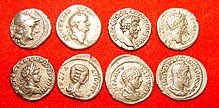Denarius
This article needs additional citations for verification. (July 2015) |

Top row left to right: 157 BC Roman Republic, AD 73 Vespasian, AD 161 Marcus Aurelius, AD 194 Septimius Severus;
Second row left to right: AD 199 Caracalla, AD 200 Julia Domna, AD 219 Elagabalus, AD 236 Maximinus Thrax
The denarius (Latin: [deːˈnaːriʊs], pl. dēnāriī [deːˈnaːriiː]) was the standard Roman silver coin from its introduction in the Second Punic War c. 211 BC[1] to the reign of Gordian III (AD 238–244), when it was gradually replaced by the Antoninianus. It continued to be minted in very small quantities, likely for ceremonial purposes, until and through the tetrarchy (293–313).[2]:87
The word dēnārius is derived from the Latin dēnī "containing ten", as its value was originally of 10 assēs.[note 1] The word for "money" descends from it in Italian (denaro), Slovene (denar), Portuguese (dinheiro), and Spanish (dinero). Its name also survives in the dinar currency.
Its symbol is represented in Unicode as
